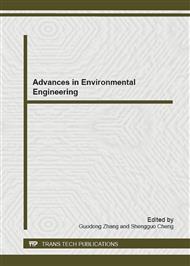p.211
p.216
p.220
p.224
p.229
p.233
p.237
p.241
p.245
Eutrophication Assessment of Reservoir Based on Matter-Element and Extension
Abstract:
The eutrophication of medium-sized reservoirs in Shenyang is assessed to explore the feasibility of matter-element and extension using in assessing the eutrophication of water. The evaluation standard is established with related factors, and the eutrophication level is determined by correlation degree. The results show that, assessing eutrophication of water with this method, can not only determine the eutrophication level exactly, but also reflects the changing trend of the water. It is more appropriate than other methods in eutrophication assessment.
Info:
Periodical:
Pages:
229-232
Citation:
Online since:
November 2012
Authors:
Price:
Сopyright:
© 2012 Trans Tech Publications Ltd. All Rights Reserved
Share:
Citation:


